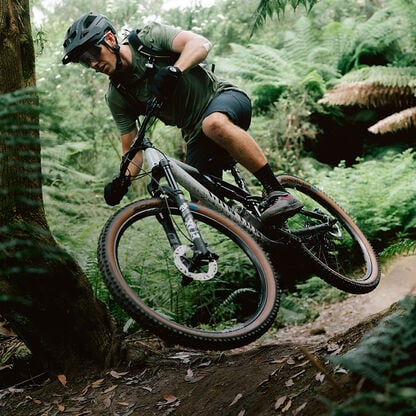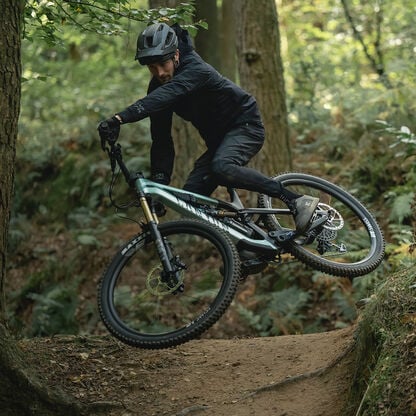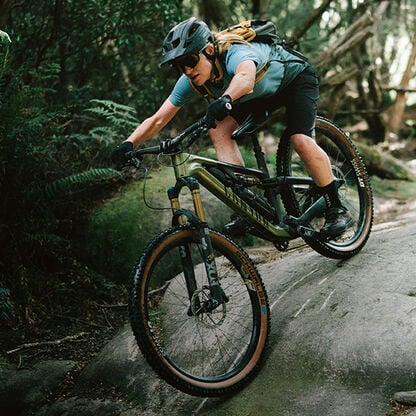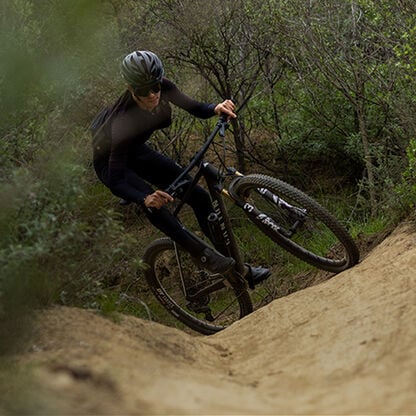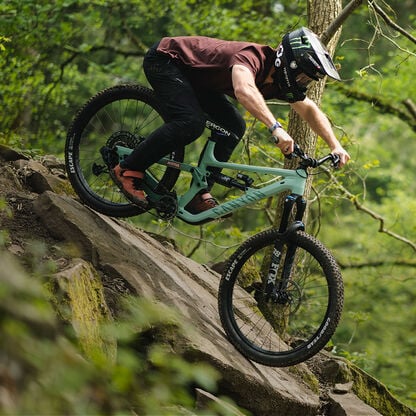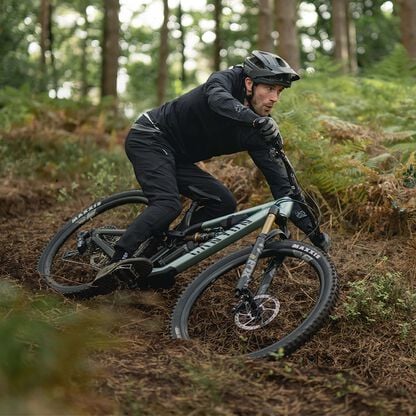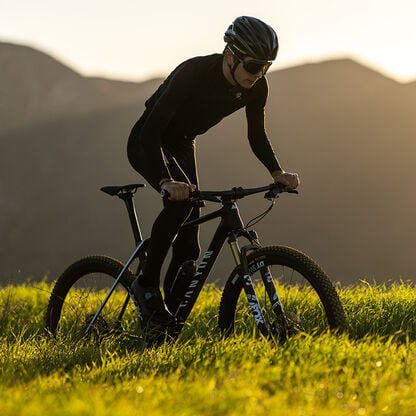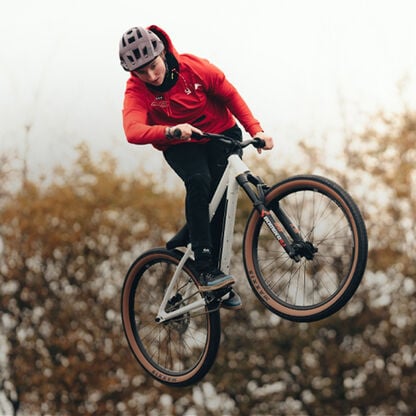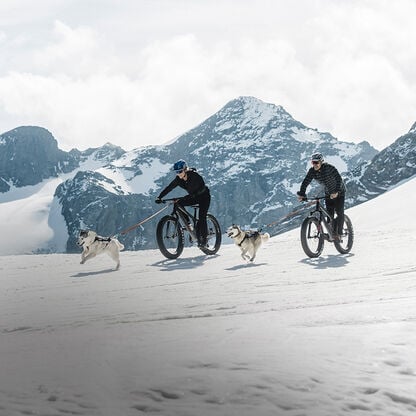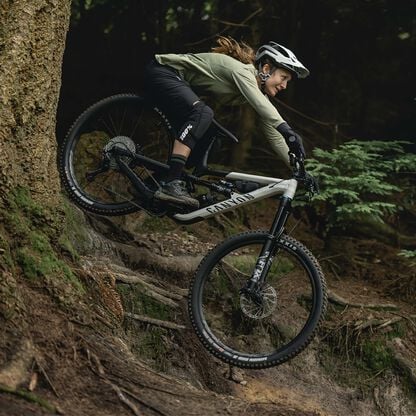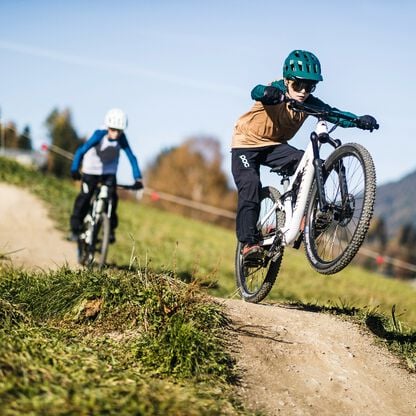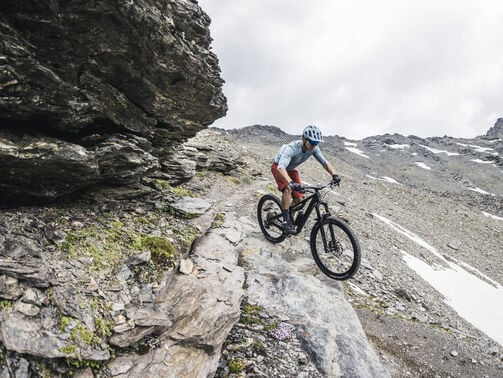Hardtail mountain bikes explained: Your comprehensive buying guide
Looking for an unfiltered, low maintenance mountain bike experience, free from complexity? Our hardtail MTB buying guide explains it all - from the perfect hardtail for beginners to the best hardtail mountain bikes for any use.

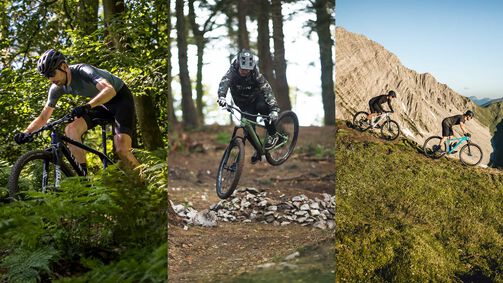
Hard Tail. The name says it all. Big tires, disc brakes, suspension forks (most of the time), and no rear suspension. Today’s hardtails bring simplicity and affordable performance to riders of all skill levels. That’s brilliant. Not all hardtails are created equal, however, nor are they all designed for the same kind of riding. We’ll spell out the differences here and help you figure out how to choose a hardtail bike that’s perfect for you.
Contents
What is a hardtail mountain bike?
Simply put, a hardtail mountain bike has all the things we expect from a modern mountain bike – big tires, disc brakes, wide handlebars and a broad range of gears to tackle a huge variety of rough terrain – but no rear suspension at all. The rear end of the bike is considered rigid; literally a hard tail.
Key features of hardtail mountain bikes
We’ve established that hardtail mountain bikes are very similar to full suspension mountain bikes in many regards; high volume off-road capable tires, disc brakes, wide ratio gears, suspension forks. But it is the rear suspension, or lack of it in this case, that sets the hardtail apart. Hardtails are simpler machines, yet they are exceptionally capable. Hardtail mountain bikes have fewer moving parts than full suspension bikes, and this means that they often weigh less than their full suspension counterparts and are less maintenance intensive to own.
Why choose a hardtail over a full-suspension bike?
We are very proud of how well our suspension bikes perform. But we also acknowledge that not everybody needs or wants full suspension. Hardtails offer a simple, unfiltered pure connection to the trail and, in skilled hands, are sometimes the best tool for the job when it comes to sessioning jump lines and ripping pump tracks.
Benefits of hardtail mountain bikes
On the whole, hardtails offer an incredible value proposition. They are less complex to manufacture, so that means that they can not only weigh less than similarly kitted full- suspension bikes but also cost less as well. Light weight and efficient power transfer means that hardtails can climb like rocketships. No suspension pivots or bearings equates to less routine maintenance with a hardtail. No rear suspension means that you are in direct contact with the trail - good riding habits will be rewarded and sloppy ones will be corrected in short order. Hardtails are great teachers!
For more on this topic, check out our hardtail vs. full suspension comprehensive guide.
Choosing the right wheel size for your hardtail
When it comes to choosing the wheel size for your hardtail, you’ll notice that the landscape is dominated by 29” wheels. However, there are also instances where you may want to ride 27.5” wheels, and in some special cases 26” wheels will make the most sense. Let’s talk about why. Remember, there isn’t really a “best” wheel size, only what works best for you.
Comparing 26” 27.5” and 29” wheels
29” wheels are a natural choice for cross-country (XC) and trail riding. Their larger diameter enables them to roll more smoothly over rough terrain, and they offer a degree of stability and control that is hard to beat. However, smaller riders may feel more comfortable on 27.5” wheels. It is easier to design a frame to perfectly fit smaller stature riders around this more compact wheel size, so you’ll notice that many of our XXS through S sized hardtails roll on 27.5” wheels.
When it comes to dirt jumps, pump tracks, tricks and trials, you’ll want 26” wheels. We spec them on our Stitched 360 because they offer a level of responsiveness, agility and strength that is impossible to beat when it comes to throwing shapes and smashing lips.
To dive deeper into the pros and cons of each wheel size, check out our full 27.5” vs. 29” MTB comparison.
Key features to consider when buying a hardtail
Frame materials
The frame is the heart of your hardtail MTB, and without suspension acting to control the wheels, the nuanced ride characteristics of different materials and construction techniques become more noticeable. The two main materials that we work with are aluminium and carbon fiber.
Aluminium is our workhorse material. It is strong, easy to work with, and competitively lightweight. It is also significantly less expensive than carbon fiber, so it offers an outstanding value proposition (check out our aluminium mountain bikes here).
Carbon fiber is our premier material. It can be “laid up” to be exceptionally stiff in one direction, but flexible in another. This “tunability” means we can build in a high degree of ride feel, while also paring weight to a bare minimum AND delivering an incredible strength to weight ratio. It’s pretty incredible stuff, but it comes at a cost (Ready to go carbon? Browse our carbon mountain bike lineup here)
Learn more in our carbon vs. aluminum mountain bike frame guide, covering weight, durability, and ride feel.
Drivetrain and brake essentials
These days, you’ll find that most drivetrains operate around a single chainring, commonly referred to as 1x (“one by”). Since there is only one chainring up front, the 11 to 13 gears out back need a huge spread (from 10 or 11 up to as many as 52 teeth) to offer the gear range you’ll need to climb the steepest hills and still speed along the flats. This gear range is in most cases controlled by a long cage rear derailleur that features a clutch. Clutch-type derailleurs maintain a greater tension on the drivetrain; keeping the chain engaged on chainring teeth, preventing the chain from being thrown off, and ensuring smooth, quiet operation (You’ll find everything you need to know about mountain bike groupsets - from entry-level to pro - right here).
Braking on hardtail mountain bikes is predominantly handled by powerful hydraulic disc brakes. Some feature two pistons to compress the brake pads against the rotors, others use four. Four-piston brakes are generally considered more powerful but are also usually found on more expensive bikes. Rotor sizes can vary from 160mm in diameter up to 200mm. Larger rotors offer greater leverage, and that usually equates to more powerful brakes. They also dissipate heat more effectively than smaller rotors, a true benefit if your rides include plenty of long and steep descents.
Suspension fork and travel types
With very few exceptions, t here will be a suspension fork at the front of your hardtail mountain bike. Aside from absorbing trail impacts and improving rider comfort, suspension forks dramatically enhance your control when charging through the roots and rocks. Accordingly, they play an important role in your bike’s handling.
Depending on its intended use, your hardtail’s forks will have somewhere between 80mm and 150mm of oil-damped travel. XC focused hardtails will generally feature forks with around 100mm of travel, smaller diameter stanchions and lighter overall weight. More aggressive hardtails designed for rougher terrain, like our Stoic, run 140mm travel forks with thicker stanchions for maximum capability and precision on technical trails. In almost all cases forks will be air-sprung, offering progressive bump absorption and nearly infinite tunability for your weight and riding style.

Geometry considerations
Geometry is the combination of physical measurements that define how a bike will behave on the trail. Important individual aspects of mountain bike geometry that contribute to this final identity include the bike’s head tube angle, seat tube angle, reach and stack, wheelbase, and bottom bracket height.
Find out how each measurement on a geometry chart affects how a bike rides in our beginner’s mountain bike geometry guide.
Individual geometry measurements are helpful data points in your quest to find the perfect bike, but don’t get too hung up on them. Remember that saying: “The whole is greater than the sum of its parts.” This applies to mountain bike geometry in particular, where the way a given bike rides and handles is not only how all those measurements work together, but also how the frame is designed and what it is made out of. There’s a lot of science and engineering and just a little bit of voodoo magic in every good bike.
Modern hardtails are all benefitting from more progressive geometry – relaxed head angles, more reach, longer wheelbases – which increase your control over tough terrain. But, as a rule of thumb, you can expect that XC hardtails (like our Exceed) will generally feature a little steeper and sharper handling than brawny all-mountain hardtails like the Stoic.
Dropper posts and tire choices
Dropper seatposts are about the best thing since sliced bread when it comes to mountain bike innovations. With the push of a button and a nudge of your bum, you can push your seatpost down and out of the way. This is invaluable when it comes to mastering steep descents or riding technical lines. Look for longer-travel droppers if you want to ride more serious terrain or if you are super tall. XC racers can get by with less dropper-post travel, and you leg-shaving minimalists can still survive without droppers if you really want to save every gram, but you’re missing out!
As for tires, we’ll try to keep this simple. This is no easy task, since tires have a huge impact on how your mountain bike behaves. Bike shop employees and seasoned riders will also gladly talk your ear off about their favorite tires and why they are better than all the rest. We do our best to strike the right balance in tire choice on our hardtails, selecting rubber that will deliver a desired ride characteristic, offer plenty of traction, and inspire confidence in a bike’s intended terrain. That said, let’s talk about some basics:
- XC race hardtails like the Exceed benefit from lightweight casings and minimalist tread; these tires accelerate sharply and roll fast, but offer less outright traction in loose and technical terrain.
- At the other end of the spectrum, bikes like the Stoic feature high-volume, aggressively-treaded tires with durable, multi-ply casings. Traction and sidewall strength are paramount for the more aggressive trail riding you’d do on a hardtail like the Stoic, but those traits come at the expense of rolling efficiency.
Whether you choose a lighter XC tire or a heavier trail model, almost all tires can be set up to run tubeless. Ditching the conventional inner tube and replacing it with tubeless valves and tire sealant decreases weight, increases rolling efficiency, improves puncture resistance, and gives you greater traction and comfort. All of our bikes arrive at your doorstep wearing inner tubes but can be easily converted to tubeless.
Different hardtail riding styles
Hardtail mountain bikes are incredibly versatile, and their performance can vary widely depending on the type of riding you’re into.
Cross country riding on a hardtail
If your goal is covering ground fast, chasing KOMs and maybe pinning race numbers onto your jersey, an XC hardtail is the way to go. At the premium end of the hardtail spectrum, we have the Exceed. It’s designed to win cross-country races with its lightweight carbon frame and high-end components. The Exceed is the weapon of choice for many world-class competitors and hard-charging riders.
Trail riding with a hardtail
If you want to explore off-road and develop your mountain biking skills, then you can’t go wrong with a do-it-all trail hardtail. Versatile and affordable, our entry-level hardtail, the Grand Canyon, is perfect for you. It features a 120mm-travel suspension fork, a capable aluminum frame and components that won’t let you down.
Aggressive all-mountain riding on a hardtail
Are black diamond trails and jump lines calling your name? If you’re ready to hit the jumps and slightly more technical terrain, the Stoic is a great choice. It packs everything we love about mountain biking into one accessible setup; simple, tough, and durable no matter where you ride.
How much should you spend on a hardtail?
As with any other bike, hardtail prices vary, but hardtails are often less expensive than a full-suspension mountain bike since they feature simpler frames and lack rear-suspension components. That said, you’ll find the best value in our aluminium hardtails like the Grand Canyon on up through the Stoic.
Carbon fiber models like our Exceed offer exceptional lightweight performance at a great value, but you can expect to pay more as the frame and component quality goes up.
How to optimize your hardtail setup
Dialing in your hardtail setup can make a big difference in comfort, control, and overall performance on the trail. Here’s what to keep in mind as you fine-tune your ride.
Setting your suspension sag
Modern air forks are easy to tune for conditions, rider weight and rider preference. All you need is a shock pump. Most forks will have a range of recommended air pressures written on the lower fork leg, just in case, but there is nothing stopping you from experimenting to find out what works best for your particular conditions and preferences.
As a rough rule of thumb, it is recommended that you run somewhere between 15-25% sag. “Sag” is the measurement of how much a fork settles when you sit on your bike in a regular riding position. Check out our essential guide to fine-tuning your MTB suspension for better performance, comfort, and control - covering key adjustable components like sag, rebound, and compression.
Adjusting cockpit and saddle position
In addition to the different MTB frame sizes available, there are some adjustments you can make to your hardtail mountain bike that can help get the fit just right. The saddle can be adjusted for height, slid fore or aft on its clamp, as well as adjusted up or down for tilt. Ideally, you want to get the height right; most people will find their happy place somewhere between 85-90% of their inseam length, or at a point where their knee is ever so slightly bent at the bottom of the pedal stroke with their foot flat and the ball of their foot resting over the pedal spindle. From there, you can adjust position fore and aft to find the most comfortable pedaling position, as well as to get more comfortable between the saddle and handlebars. Finally, saddle tilt can be adjusted to your preference. That’s a mighty personal thing, so we’ll politely say “start with the saddle roughly level and go from there” then we’ll turn our backs while you get comfortable.
You’ll notice that there are some spacers between the headset and stem of your bike. These can be placed below or above the stem, and allow you to fine tune your handlebar height (or “stack”, in geometry terms). Higher handlebars result in a more upright riding posture. Some riders prefer this for comfort and improved control on steep descents. Other riders prefer a lower handlebar to keep their weight more forward for better cornering feel.
Tire pressure and tubeless setup
Should you set your tires up to run tubeless? Yes! We have some very easy to follow videos over on our tech hub that walk you through it. Trust us, your life will be better.
Okay, now that we have that out of the way, let’s talk about tire pressure. For the longest time, cyclists of every type adhered to the notion that more air pressure equaled less rolling resistance and everyone pumped their tires up as hard as possible everywhere. These were dark times. The truth is, rolling efficiency depends in large part on how well a tire deforms to terrain and how smoothly it can roll without deflecting off every little surface imperfection. This is true both on the road and off the road. So, take note of the tiny letters on the side of your tires that tell you what sort of minimum and maximum pressures are recommended for that tire, and find out what feels comfortable for you.
Click through to get expert advice on adjusting your MTB tire pressure for different terrains and riding styles.

Why should you buy a hardtail?
We tend to overcomplicate our lives. It’s part of being human. What starts out as a quest for comfort, or a little edge in performance, sooner or later ends up smothering us in complexity and expense. Hardtail mountain bikes are the great mountain biking alternative to all that. They offer peace of mind and incredible value for your hard-earned money.
Hardtails are elementally simple. Gloriously uncomplicated. Fun. Easy. With solid riding techniques, you can do almost everything on a hardtail that you can on a more expensive, more complicated full-suspension bike.
Still not sure which mountain bike is right for you? Check out our comprehensive MTB buying guide and our top picks for beginner-friendly MTB models. And if you’re torn between specific bikes, our bike comparison tool makes it easy to find the perfect match.
Aaand that’s it – enjoy every climb, corner, and drop on your new Canyon hardtail 🤙!
Discover our Mountain Bikes
Did this article help?
Thank you for your feedback
